Progress in Bi2WO6-Based Materials for Electrochemical Sensing and Supercapacitor Applications
Abstract
1. Introduction
2. Synthesis Methods
2.1. Hydrothermal Method
2.2. Solvothermal Method
2.3. Electrochemical Method
2.4. Sol–Gel Method
2.5. Microwave Method
3. Progress in Electrochemical Sensors
4. Progress in SCs
4.1. Bi2WO6-Based Materials for SCs
4.2. Bi2WO6-Based Compoiste Materials for SCs
5. Conclusions, Limitations and Perspectives
- Pristine Bi2WO6 suffers from low conductivity, which needs to be addressed.
- Although several efforts were made to enhance the conductivity of Bi2WO6 by combining it with conductive supports such as MXene or rGO, synthetic procedures are not cost-effective for practical applications.
- DPV is a more sensitive technique, but, in some cases, the presence of similar interfering substances affects the selectivity of electrochemical sensors.
- Real sample studies are conducted using the standard addition method, which exhibits accepted recovery. However, we believe that such methods are not reliable for real sample analysis. Thus, new methods should be developed.
- The depth mechanism for sensing applications should be studied.
- For SCs, stability is the major concern, which needs to be properly studied in depth.
- Green and cost-effective methods need to be developed for scalability and practical applications.
- Electrochemical sensors can be combined with machine learning technology for the accurate analysis of environmental pollutants.
- Electrochemical sensors can be explored in smartphone-based devices for environmental monitoring.
- Flexible and wearable electrochemical sensors can be developed for environmental monitoring.
- MXene is a new material, and its potential is not fully explored. Thus, Bi2WO6 and MXene-based materials should be studied in depth, and a cost-effective and acid etching-free method should be developed for the transformation of MAX to MXene.
Author Contributions
Funding
Institutional Review Board Statement
Informed Consent Statement
Data Availability Statement
Acknowledgments
Conflicts of Interest
References
- Al-Kadhi, N.S.; Hefnawy, M.A.; Alamro, F.S.; Pashameah, R.A.; Ahmed, H.A.; Medany, S.S. Polyaniline-Supported Nickel Oxide Flower for Efficient Nitrite Electrochemical Detection in Water. Polymers 2023, 15, 1804. [Google Scholar] [CrossRef]
- Zhang, X.; Qin, F.; Zhong, Y.; Xiao, T.; Yu, Q.; Zhu, X.; Feng, W.; Qi, Z. Preparation and Photocatalytic Performance of In2O3/Bi2WO6 Type II Heterojunction Composite Materials. Molecules 2024, 29, 4911. [Google Scholar] [CrossRef]
- Yoon, J.; Hong, W.-K.; Kim, Y.; Park, S.-Y. Nanostructured Vanadium Dioxide Materials for Optical Sensing Applications. Sensors 2023, 23, 6715. [Google Scholar] [CrossRef] [PubMed]
- Pasquini, L. Nanostructured Materials for Energy Storage and Conversion. Nanomaterials 2022, 12, 1583. [Google Scholar] [CrossRef] [PubMed]
- Tanabe, K. Nanostructured Materials for Solar Cell Applications. Nanomaterials 2022, 12, 26. [Google Scholar] [CrossRef] [PubMed]
- Harish, V.; Tewari, D.; Gaur, M.; Yadav, A.B.; Swaroop, S.; Bechelany, M.; Barhoum, A. Review on Nanoparticles and Nanostructured Materials: Bioimaging, Biosensing, Drug Delivery, Tissue Engineering, Antimicrobial, and Agro-Food Applications. Nanomaterials 2022, 12, 457. [Google Scholar] [CrossRef]
- Panžić, I.; Bafti, A.; Radovanović-Perić, F.; Gašparić, D.; Shi, Z.; Borenstein, A.; Mandić, V. Advancements in Nanostructured Functional Constituent Materials for Gas Sensing Applications: A Comprehensive Review. Appl. Sci. 2025, 15, 2522. [Google Scholar] [CrossRef]
- Barhoum, A.; García-Betancourt, M.L.; Jeevanandam, J.; Hussien, E.A.; Mekkawy, S.A.; Mostafa, M.; Omran, M.M.; Abdalla, M.S.; Bechelany, M. Review on Natural, Incidental, Bioinspired, and Engineered Nanomaterials: History, Definitions, Classifications, Synthesis, Properties, Market, Toxicities, Risks, and Regulations. Nanomaterials 2022, 12, 177. [Google Scholar] [CrossRef]
- Bandas, C.; Orha, C.; Nicolaescu, M.; Morariu, M.-I.; Lăzău, C. 2D and 3D Nanostructured Metal Oxide Composites as Promising Materials for Electrochemical Energy Storage Techniques: Synthesis Methods and Properties. Int. J. Mol. Sci. 2024, 25, 12521. [Google Scholar] [CrossRef]
- Das, A.; Peu, S.D.; Hossain, M.S.; Akanda, M.A.M.; Salah, M.M.; Akanda, M.M.H.; Rahman, M.; Das, B.K. Metal Oxide Nanosheet: Synthesis Approaches and Applications in Energy Storage Devices (Batteries, Fuel Cells, and Supercapacitors). Nanomaterials 2023, 13, 1066. [Google Scholar] [CrossRef]
- He, Y.; Jiao, M. A Mini-Review on Metal Oxide Semiconductor Gas Sensors for Carbon Monoxide Detection at Room Temperature. Chemosensors 2024, 12, 55. [Google Scholar] [CrossRef]
- Subhan, M.A.; Neogi, N.; Choudhury, K.P.; Rahman, M.M. Advances in Biosensor Applications of Metal/Metal-Oxide Nanoscale Materials. Chemosensors 2025, 13, 49. [Google Scholar] [CrossRef]
- Zhang, Q.; Jiang, Z.; Wang, M.; Ge, X. Gamma ray radiation effect on Bi2WO6 photocatalyst. Chin. J. Chem. Phys. 2018, 31, 701–706. [Google Scholar] [CrossRef]
- El Aouni, A.; El Ouardi, M.; Arab, M.; Saadi, M.; Haspel, H.; Kónya, Z.; Ben Ali, A.; Jada, A.; BaQais, A.; Ait Ahsaine, H. Design of Bismuth Tungstate Bi2WO6 Photocatalyst for Enhanced and Environmentally Friendly Organic Pollutant Degradation. Materials 2024, 17, 1029. [Google Scholar] [CrossRef]
- Kovalevskiy, N.; Cherepanova, S.; Gerasimov, E.; Lyulyukin, M.; Solovyeva, M.; Prosvirin, I.; Kozlov, D.; Selishchev, D. Enhanced Photocatalytic Activity and Stability of Bi2WO6–TiO2-N Nanocomposites in the Oxidation of Volatile Pollutants. Nanomaterials 2022, 12, 359. [Google Scholar] [CrossRef]
- Jiang, H.; He, J.; Deng, C.; Hong, X.; Liang, B. Advances in Bi2WO6-Based Photocatalysts for Degradation of Organic Pollutants. Molecules 2022, 27, 8698. [Google Scholar] [CrossRef]
- Kudo, A.; Hijii, S. H2 or O2 evolution from aqueous solutions on layered oxide photocatalysts consisting of Bi3+ with 6s2 configuration and d0 transition metal ions. Chem. Lett. 1999, 28, 1103–1104. [Google Scholar] [CrossRef]
- Wang, D.; Zhen, Y.; Xue, G.; Fu, G.; Lin, X.; Li, D. Synthesis of mesoporous Bi2WO6 architectures and their gas sensitivity to ethanol. J. Mater. Chem. C 2013, 1, 4153–4162. [Google Scholar] [CrossRef]
- Zeng, T.; Yu, X.; Hui, S.; Zhou, Z.; Dong, X. Structural and electrical properties of Bi2WO6 piezoceramics prepared by solid state reaction method. Mater. Res. Bull. 2015, 68, 271–275. [Google Scholar] [CrossRef]
- Ma̧czka, M.; Macalik, L.; Hermanowicz, K.; Kȩpiński, L.; Tomaszewski, P. Phonon properties of nanosized bismuth layered ferroelectric material—Bi2WO6. J. Raman Spectrosc. 2009, 41, 1059–1066. [Google Scholar] [CrossRef]
- Zhu, J.; Wang, J.G.; Bian, Z.F. Solvothermal synthesis of highly active Bi2WO6 visible photocatalyst. Res. Chem. Intermed. 2009, 35, 799–806. [Google Scholar] [CrossRef]
- Gao, Y.; Shan, X.; Song, D.; Gulnigar, E.; Wang, Y.; Yang, W.; Chen, Y. One-step solvothermal synthesis of hollow Bi2WO6 photocatalyst. Can. J. Chem. Eng. 2019, 97, 2440–2446. [Google Scholar] [CrossRef]
- Jonjana, S.; Phuruangrat, A.; Thongtem, S.; Thongtem, T. Synthesis, characterization and photocatalysis of heterostructure AgBr/Bi2WO6 nanocomposites. Mater. Lett. 2018, 216, 92–96. [Google Scholar] [CrossRef]
- Zhang, Z.J.; Wang, W.Z.; Shang, M.; Yin, W.Z. Low-temperature combustion synthesis of Bi2WO6 nanoparticles as a visible-light-driven photocatalyst. J. Hazard. Mater. 2010, 177, 1013–1018. [Google Scholar] [CrossRef]
- Xu, F.; Xu, C.; Chen, H.; Wu, D.; Gao, Z.; Ma, X.; Zhang, Q.; Jiang, K. The synthesis of Bi2S3/2D-Bi2WO6 composite materials with enhanced photocatalytic activities. J. Alloys Compd. 2019, 780, 634–642. [Google Scholar] [CrossRef]
- Liu, Y.; Lv, H.; Hu, J.; Li, Z. Synthesis and characterization of Bi2WO6 nanoplates using egg white as a biotemplate through sol-gel method. Mater. Lett. 2015, 139, 401–404. [Google Scholar] [CrossRef]
- Huang, Y.; Ai, Z.; Ho, W.; Chen, M.; Lee, S. Ultrasonic spray pyrolysis synthesis of porous Bi2WO6 microspheres and their visible-light-induced photocatalytic removal of NO. J. Phys. Chem. C 2010, 114, 6342–6349. [Google Scholar] [CrossRef]
- Wang, W.; Guo, M.; Lu, D.; Wang, W.; Fu, Z. Effect of HNO3 concentration on the morphologies and properties of Bi2WO6 photocatalyst synthesized by a hydrothermal method. Crystals 2016, 6, 75. [Google Scholar] [CrossRef]
- Zhang, H.; Fan, Z.; Chai, Q.; Li, J. Facile Synthesis of a Bi2WO6/BiO2−x Heterojunction for Efficient Photocatalytic Degradation of Ciprofloxacin under Visible Light Irradiation. Catalysts 2023, 13, 469. [Google Scholar] [CrossRef]
- Liu, Z.; Shen, L.; He, X.; Pun, E.Y.B.; Lin, H. Rare-earth functioned Bi2WO6 nanofibers via electrospinning: Boosted catalytic performance and contact-free temperature monitoring on degradation process. Colloid Interface Sci. Commun. 2021, 44, 100494. [Google Scholar] [CrossRef]
- Dumrongrojthanath, P.; Phuruangrat, A.; Doungarno, K.; Thongtem, T.; Patiphatpanya, P.; Thongtem, S. Microwave-hydrothermal synthesis of BiOBr/Bi2WO6 nanocomposites for enhanced photocatalytic performance. Ceram. Int. 2018, 44, S148–S151. [Google Scholar] [CrossRef]
- Zhang, Z.; Lin, Y.; Liu, F. Preparation, crystallization and properties of Bi2WO6 nanoparticles. Colloids Surf. A Physicochem. Eng. Asp. 2020, 590, 124493. [Google Scholar] [CrossRef]
- Zhang, L.; Shi, M.; Zhang, S.; Yue, F.; Yang, C.; Meng, Y.; Li, W.; Li, C.; Berrettoni, M.; Zamponi, S.; et al. Preparation of Bi2WO6/MXene(Ti3C2Tx) Composite Material and Its Photothermal Catalytic Reduction of CO2 in Air. Catalysts 2024, 14, 859. [Google Scholar] [CrossRef]
- Luo, D.; Chen, Q.; Qiu, Y.; Liu, B.; Zhang, M. Carbon Dots-Decorated Bi2WO6 in an Inverse Opal Film as a Photoanode for Photoelectrochemical Solar Energy Conversion under Visible-Light Irradiation. Materials 2019, 12, 1713. [Google Scholar] [CrossRef]
- El-Muraikhi, M.D.; Ayesh, A.I.; Mirzaei, A. Review of nanostructured Bi2O3, Bi2WO6, and BiVO4 as resistive gas sensors. Surf. Interfaces 2025, 60, 106003. [Google Scholar] [CrossRef]
- Wang, L.; Wang, J.; Fei, Y.; Cheng, H.; Pan, H.; Wu, C. Ag3PO4/Bi2WO6 Heterojunction Photocatalyst with Remarkable Visible-Light-Driven Catalytic Activity. Crystals 2023, 13, 1531. [Google Scholar] [CrossRef]
- Wang, Y.Q.; Yang, C.; Gan, L.H. Preparation of direct Z-scheme Bi2WO6/TiO2 heterojunction by one-step solvothermal method and enhancement mechanism of photocatalytic H2 production. Int. J. Hydrogen Energy 2023, 48, 19372–19384. [Google Scholar] [CrossRef]
- Mandari, K.K.; Son, N.; Kang, M. Ag3PO4–Bi2WO6–TiO2 as a high performance electrocatalyst for oxygen evolution reaction. Appl. Surf. Sci. 2021, 566, 150681. [Google Scholar] [CrossRef]
- Wang, L.; Zhu, B.; Zhang, S.; Huang, W. Flower-Like Au–CuO/Bi2WO6 Microsphere Catalysts: Synthesis, Characterization, and Their Catalytic Performances for CO Oxidation. Catalysts 2017, 7, 266. [Google Scholar] [CrossRef]
- Zhou, Y.; Lv, P.; Meng, X.; Tang, Y.; Huang, P.; Chen, X.; Shen, X.; Zeng, X. CTAB-Assisted Fabrication of Bi2WO6 Thin Nanoplates with High Adsorption and Enhanced Visible Light-Driven Photocatalytic Performance. Molecules 2017, 22, 859. [Google Scholar] [CrossRef]
- He, Y.; Gao, H.; Liu, J. A Visible-Light-Active CuS/MoS2/Bi2WO6 Aptamer Sensitively Detects the Non-Steroidal Anti-Inflammatory Drug Diclofenac. Nanomaterials 2022, 12, 2834. [Google Scholar] [CrossRef]
- Ahmed, M.; Huan, W.; Ali, N.; Shafi, A.; Ehsan, M.; Abdelrahman, K.; Khan, A.A.; Abbasi, S.S.; Fnais, M.S. The Effect of Energy Consumption, Income, and Population Growth on CO2 Emissions: Evidence from NARDL and Machine Learning Models. Sustainability 2023, 15, 11956. [Google Scholar] [CrossRef]
- Ben-Salha, O.; Hakimi, A.; Zaghdoudi, T.; Soltani, H.; Nsaibi, M. Assessing the Impact of Fossil Fuel Prices on Renewable Energy in China Using the Novel Dynamic ARDL Simulations Approach. Sustainability 2022, 14, 10439. [Google Scholar] [CrossRef]
- Yassine, M.; Fabris, D. Performance of Commercially Available Supercapacitors. Energies 2017, 10, 1340. [Google Scholar] [CrossRef]
- Lakshmi, K.C.S.; Vedhanarayanan, B. High-Performance Supercapacitors: A Comprehensive Review on Paradigm Shift of Conventional Energy Storage Devices. Batteries 2023, 9, 202. [Google Scholar] [CrossRef]
- Karbasi, M.; Karimzadeh, F.; Raeissi, K.; Rtimi, S.; Kiwi, J.; Giannakis, S.; Pulgarin, C. Insights into the Photocatalytic Bacterial Inactivation by Flower-Like Bi2WO6 under Solar or Visible Light, Through in Situ Monitoring and Determination of Reactive Oxygen Species (ROS). Water 2020, 12, 1099. [Google Scholar] [CrossRef]
- Guo, W.; Jian, L.; Wang, X.; Zeng, W. Hydrothermal synthesis of Ni-doped hydrangea-like Bi2WO6 and the enhanced gas sensing property to n-butanol. Sens. Actuators B Chem. 2022, 357, 131396. [Google Scholar] [CrossRef]
- Wang, L.; Guo, C.; Chen, F.; Ning, J.; Zhong, Y.; Hu, Y. pH-induced hydrothermal synthesis of Bi2WO6 nanoplates with controlled crystal facets for switching bifunctional photocatalytic water oxidation/reduction activity. J. Colloid Interface Sci. 2021, 602, 868–879. [Google Scholar] [CrossRef] [PubMed]
- Li, Z.; Luo, M.; Li, B.; Lin, Q.; Liao, X.; Yu, H.; Yu, C. 3-D hierarchical micro/nano-structures of porous Bi2WO6: Controlled hydrothermal synthesis and enhanced photocatalytic performances. Microporous Mesoporous Mater. 2021, 313, 110830. [Google Scholar] [CrossRef]
- Gao, X.; Fei, J.; Dai, Y.; Fu, F. Hydrothermal synthesis of series Cu-doped Bi2WO6 and its application in photo-degradative removal of phenol in wastewater with enhanced efficiency. J. Mol. Liq. 2018, 256, 267–276. [Google Scholar] [CrossRef]
- Guo, X.; Zhang, J.; Xu, J.; Dan, X.; Guo, F.; Zhang, B.; Zhang, L.; Wang, Q.; Hou, J. Engineering Bi2WO6-loaded TiO2 nanotubes for enhanced photocatalytic organic wastewater degradation and photoelectric conversion. Environ. Res. 2025, 282, 122089. [Google Scholar] [CrossRef]
- Kuo, C.-Y.; Wu, C.-H.; Hsu, M.-J. Single-step solvothermal synthesis of boron-doped Bi2WO6 visible-light-induced photocatalyst and determination of surface characteristics and photocatalytic activities. Desalination Water Treat. 2017, 81, 209–215. [Google Scholar] [CrossRef]
- Hu, S.-P.; Xu, C.-Y.; Zhen, L.-Z. Solvothermal synthesis of Bi2WO6 hollow structures with excellent visible-light photocatalytic properties. Mater. Lett. 2013, 95, 117–120. [Google Scholar] [CrossRef]
- Wu, L.; Bi, J.; Li, Z.; Wang, X.; Fu, X. Rapid preparation of Bi2WO6 photocatalyst with nanosheet morphology via microwave-assisted solvothermal synthesis. Catal. Today 2008, 131, 15–20. [Google Scholar] [CrossRef]
- Zhu, Z.; Ren, Y.; Li, Q.; Liu, H.; Weng, H. One-pot electrodeposition synthesis of Bi2WO6/graphene composites for photocatalytic applications under visible light irradiation. Ceram. Int. 2018, 44, 3511–3516. [Google Scholar] [CrossRef]
- Orimolade, B.O.; Idris, A.O.; Feleni, U.; Mamba, B. Peroxymonosulfate assisted photoelectrocatalytic degradation of pharmaceuticals at a FTO-Bi2WO6 electrode: Mechanism and kinetics studies. Catal. Commun. 2022, 169, 106481. [Google Scholar] [CrossRef]
- Zhang, G.; Lü, F.; Li, M.; Yang, J.; Zhang, X.; Huang, B. Synthesis of nanometer Bi2WO6 synthesized by sol–gel method and its visible-light photocatalytic activity for degradation of 4BS. J. Phys. Chem. Solids 2010, 71, 579–582. [Google Scholar] [CrossRef]
- Sun, C.; Wang, Y.; Su, Q. Sol-gel synthesis of Bi2WO6/graphene thin films with enhanced photocatalytic performance for nitric monoxide oxidation under visible light irradiation. Chem. Phys. Lett. 2018, 702, 49–56. [Google Scholar] [CrossRef]
- Han, T.; Wang, X.; Ma, Y.; Shao, G.; Dong, X.; Yu, C. Mesoporous Bi2WO6 sheets synthesized via a sol–gel freeze-drying method with excellent photocatalytic performance. J. Sol.-Gel. Sci.Technol. 2017, 82, 101–108. [Google Scholar] [CrossRef]
- Liu, T.; Xue, F.; Wang, B.; Wang, R.; Cao, W.; Zhao, X.; Xia, Y.; Jin, W.; Zhang, Y.; Lin, H.; et al. Rapid microwave synthesis of Bi2WO6 for C=C bonds oxidative cleavage to ketones with visible light irradiation in aerobic micellar medium. J. Catal. 2023, 417, 41–51. [Google Scholar] [CrossRef]
- Li, Z.-Q.; Chen, X.-T.; Xue, Z.-L. Microwave-assisted synthesis and photocatalytic properties of flower-like Bi2WO6 and Bi2O3–Bi2WO6 composite. J. Colloid Interface Sci. 2013, 394, 69–77. [Google Scholar] [CrossRef]
- Liu, Y.; Shi, L.; Srinivasakannan, C.; Qu, W.; Lu, J.; Liu, Q. Low-temperature microwave-assisted synthesis of Bi2WO6/Bi2S3 heterojunction for photocatalytic reduction of Cr(VI) in industrial wastewater. J. Alloys Compd. 2024, 997, 174842. [Google Scholar] [CrossRef]
- Peng, L.; Dong, S.; Xie, H.; Gu, G.; He, Z.; Lu, J.; Huang, T. Sensitive simultaneous determination of diethylstilbestrol and bisphenol A based on Bi2WO6 nanoplates modified carbon paste electrode. J. Electroanal. Chem. 2014, 726, 15–20. [Google Scholar] [CrossRef]
- Liu, H.; Guo, K.; Duan, C.; Chen, X.; Zhu, Z. A novel biosensor based on the direct electrochemistry of horseradish peroxidase immobilized in the three-dimensional flower-like Bi2WO6 microspheres. Mater. Sci. Eng. C 2016, 64, 243–248. [Google Scholar] [CrossRef]
- Vinothkumar, V.; Sangili, A.; Chen, S.-M.; Chen, T.-W.; Abinaya, M.; Sethupathi, V. Voltammetric determination of Sudan I by using Bi2WO6 nanosheets modified glassy carbon electrode. Int. J. Electrochem. Sci. 2020, 15, 2414–2429. [Google Scholar] [CrossRef]
- Xu, H.; Shang, H.; Liu, Q.; Wang, C.; Di, J.; Chen, C.; Jin, L.; Du, Y. Dual mode electrochemical-photoelectrochemical sensing platform for hydrogen sulfide detection based on the inhibition effect of titanium dioxide/bismuth tungstate/silver heterojunction. J. Colloid Interface Sci. 2021, 581, 323–333. [Google Scholar] [CrossRef] [PubMed]
- Hu, S.; Fei, Q.; Li, Y.; Wang, B.; Yu, Y. Br-terminated 2D Bi2WO6 nanosheets as a sensitive light-regenerated electrochemical sensor for detecting sulfamethoxazole antibiotic. Surf. Interfaces 2021, 25, 101302. [Google Scholar] [CrossRef]
- Amalraj, A.J.J.; Wang, S.-F. An effective morphology controlled hydrothermal synthesis of Bi2WO6 and its application in riboflavin electrochemical sensor. Colloids Surf. A Physicochem. Eng. Asp. 2022, 648, 129183. [Google Scholar] [CrossRef]
- Alanazi, A.K.; Kumar, P.S.; Ramya, M.; Abo-Dief, H.M.; Rangasamy, G. Bifunctional electrode of bismuth tungsten for electrochemical sensing applications. Chemosphere 2023, 334, 139014. [Google Scholar] [CrossRef]
- Tang, N.; Shi, S.; Zhou, C.; Ding, J.; Chen, A.; He, Q.; Wang, W. Electrochemically ultrasensitive detection of ampicillin using enzyme-mediated metallo-β-lactamase/CS/Bi2WO6/MWCNTs-COOH biosensor. Microchem. J. 2024, 207, 112294. [Google Scholar] [CrossRef]
- Thenrajan, T.; Malar, M.M.; Kumaravel, S.; Rajaram, R.; Kundu, S.; Wilson, J. Bismuth tungstate nanocomposites for simultaneous detection of hydroquinone and resorcinol. Mater. Adv. 2024, 5, 1691–1701. [Google Scholar] [CrossRef]
- Shad, N.A.; Rakha, A.; Qayyum, M.A.; Siddiqi, M.H.; Mahmood, Z.; Nazir, S.; Khan, M.F.; Sajid, M.M.; Rehman, R.A.; Riaz, A.; et al. Zn3(VO4)2/Bi2WO6 composite based versatile platform for cotinine sensing and latent fingerprints development by using multiple modalities. Mater. Sci. Eng. B 2024, 301, 117203. [Google Scholar] [CrossRef]
- Veeralingam, S.; Badhulika, S. Biconcave Bi2WO6 nanoparticles for UV light-activated detection of nicotine in human sweat and cigarette samples. ACS Appl. Nano Mater. 2020, 3, 12250–12259. [Google Scholar] [CrossRef]
- Peng, J.; Zhuge, W.; Liu, Y.; Zhang, C.; Yang, W.; Huang, Y. Photoelectrochemical dopamine sensor based on Cu-doped Bi2WO6 micro-flowers sensitized cobalt tetraaminophthalocyanine functionalized graphene oxide. J. Electrochem. Soc. 2019, 166, B1612. [Google Scholar] [CrossRef]
- Xu, R.; Wei, D.; Du, B.; Cao, W.; Fan, D.; Zhang, Y.; Wei, Q.; Ju, H. A photoelectrochemical sensor for highly sensitive detection of amyloid beta based on sensitization of Mn:CdSe to Bi2WO6/CdS. Biosens. Bioelectron. 2018, 122, 37–42. [Google Scholar] [CrossRef]
- Rajaji, U.; Govindasamy, M.; Chen, S.-M.; Chen, T.-W.; Liu, X.; Chinnapaiyan, S. Microwave-assisted synthesis of Bi2WO6 flowers decorated graphene nanoribbon composite for electrocatalytic sensing of hazardous dihydroxybenzene isomers. Compos. Part B Eng. 2018, 152, 220–230. [Google Scholar] [CrossRef]
- Verma, A.; Kumar, S.; Fu, Y.-P. A ternary-hybrid as efficiently photocatalytic antibiotic degradation and electrochemical pollutant detection. Chem. Eng. J. 2021, 408, 127290. [Google Scholar] [CrossRef]
- Muthumariyappan, A.; Rajaji, U.; Chen, S.-M.; Chen, T.-W.; Li, Y.-L.; Ramalingam, R.J. One-pot sonochemical synthesis of Bi2WO6 nanospheres with multilayer reduced graphene nanosheets modified electrode as rapid electrochemical sensing platform for high sensitive detection of oxidative stress biomarker in biological sample. Ultrason. Sonochem. 2019, 57, 233–241. [Google Scholar] [CrossRef]
- Kavinkumar, V.; Verma, A.; Uma, K.; Moscow, S.; Jothivenkatachalam, K.; Fu, Y.-P. Plasmonic metallic silver induced Bi2WO6/TiO2 ternary junction towards the photocatalytic, electrochemical OER/HER, antibacterial and sensing applications. Appl. Surf. Sci. 2021, 569, 150918. [Google Scholar] [CrossRef]
- Zare, N.; Karimi-Maleh, H.; Darabi, R.; Fu, L.; Ghalkhani, M.; Karaman, O. Bi2WO6/Nb4C3Tx/dsDNA bio-nano-engineered composite as a powerful biosensor component to diagnose and monitor pemetrexed in pharmaceutical and environmental fluids. Adv. Compos. Hybrid Mater. 2025, 8, 88. [Google Scholar] [CrossRef]
- Karaman, C.; Yola, B.B.; Karaman, O.; Atar, N.; Polat, İ.; Yola, M.L. Sensitive sandwich-type electrochemical SARS-CoV-2 nucleocapsid protein immunosensor. Microchim. Acta 2021, 188, 425. [Google Scholar] [CrossRef] [PubMed]
- Ndebele, N.; Mgidlana, S.; Nyokong, T. Electrochemical detection of nitrite using an asymmetrically substituted cobalt phthalocyanine conjugated to metal tungstate nanoparticles. Electroanalysis 2022, 34, 1348. [Google Scholar] [CrossRef]
- Liu, C.; Ye, C. Bi2WO6/Ti3C2 MXene quantum dots heterostructure-based label-free photoelectrochemical aptamer sensor for ultrasensitive kanamycin monitoring. J. Electrochem. Soc. 2023, 170, 107502. [Google Scholar] [CrossRef]
- Yu, L.; Li, J.; Zhang, J.; Chen, X.; Yuan, M.; Zhang, Q.; Xu, B.; Yao, Z.; Xu, Q. Dual 3D structural Bi2WO6@graphene hydrogel composites modified molecularly imprinted polymers: Application for sensitive photoelectrochemical sensing of 4-nitrophenol in PM2.5. J. Appl. Polym. Sci. 2025, 142, e56699. [Google Scholar] [CrossRef]
- Pal, S.; Mahamiya, V.; Ray, P.; Sarkar, A.; Sultana, F.; Adhikary, B.; Chakraborty, B.; Show, B. β-Bi2O3–Bi2WO6 nanocomposite ornated with meso-tetraphenylporphyrin: Interfacial electrochemistry and photoresponsive detection of nanomolar hexavalent Cr. Inorg. Chem. 2023, 62, 21201–21223. [Google Scholar] [CrossRef]
- Nithya, V.D.; Selvan, R.K.; Kalpana, D.; Vasylechko, L.; Sanjeeviraja, C. Synthesis of Bi2WO6 nanoparticles and its electrochemical properties in different electrolytes for pseudocapacitor electrodes. Electrochim. Acta 2013, 109, 720–731. [Google Scholar] [CrossRef]
- Jalalah, M.; Sasmal, A.; Nayak, A.K.; Harraz, F.A. Rapid, external acid-free synthesis of Bi2WO6 nanocomposite for efficient supercapacitor application. J. Taiwan Inst. Chem. Eng. 2023, 143, 104697. [Google Scholar] [CrossRef]
- Kumar, S.A.; Sindhuja, V.; Gowdhaman, A.; Balaji, C.; Ramesh, R.; Anbarasan, P.M. Construction of vertically aligned MnCo2O4 needles and Bi2WO6 globules as optimal electrode materials for hybrid supercapacitor. Electrochim. Acta 2023, 459, 142545. [Google Scholar] [CrossRef]
- Shembade, U.V.; Gurav, S.R.; Gurav, A.N.; Wategaonkar, S.B.; Padalkar, N.S.; Sonkawade, R.G.; Park, J.P.; Moholkar, A.V. Exploring the effect of concentration on hydrothermally synthesized mesoporous spherical nanoflowers of bismuth tungstate for hybrid supercapacitor and water-splitting applications. J. Energy Storage 2024, 89, 111679. [Google Scholar] [CrossRef]
- Wang, F.; Yang, H.; Zhang, H.; Su, J.; Wang, X. Electrochemical performance of morphologically different Bi2WO6 nanostructures synthesized via a hydrothermal route. J. Electron. Mater. 2017, 46, 182–187. [Google Scholar] [CrossRef]
- Karnan, M.; Lolupiman, K.; Okhawilai, M.; Pattananuwat, P.; Shetty, M.; Venkateshalu, S.; Chen, J.S.; Tan, P.; Qin, J. Nanoarchitectonic marvels: Pioneering one-pot synthesis of Bi2WO6 nanostructures for breakthrough in symmetric supercapacitor innovation. ACS Appl. Energy Mater. 2024, 7, 5490–5500. [Google Scholar] [CrossRef]
- Pramila, S.; Ranganatha, V.L.; Soundarya, T.L.; Ramu, R.; Nagaraju, G.; Mallikarjunaswamy, C. Eco-mediated synthesis of visible active Bi2WO6 nanoparticles and its performance towards photocatalyst, supercapacitor, biosensor, and antioxidant activity. J. Clust. Sci. 2022, 33, 2233–2248. [Google Scholar] [CrossRef]
- Nithya, V.D.; Selvan, R.K.; Vasylechko, L.; Sanjeeviraja, C. Effect of carbon coating on the electrochemical properties of Bi2WO6 nanoparticles by PVP-assisted sonochemical method. J. Appl. Electrochem. 2015, 45, 473–485. [Google Scholar] [CrossRef]
- Nithya, V.D.; Selvan, R.K.; Vasylechko, L.; Sanjeeviraja, C. Surfactant assisted sonochemical synthesis of Bi2WO6 nanoparticles and their improved electrochemical properties for use in pseudocapacitors. RSC Adv. 2014, 4, 4343–4352. [Google Scholar] [CrossRef]
- Shetty, M.; Manickavasakam, K.; Sabbanahalli, C.; Bekal, C.; Misnon, I.I.; Subrahmanya, A.P.; Roy, K.; Shivaramu, P.D.; Shenoy, S.B.; Rangappa, D. Rapid single pot synthesis of hierarchical Bi2WO6 microspheres/RGO nanocomposite and its application in energy storage: A supercritical water approach. J. Energy Storage 2023, 72, 108116. [Google Scholar] [CrossRef]
- Lee, K.-C.; Huang, J.-H.; Pang, W.K.; Wang, K.-S.; Hsu, S.-C.; Weng, H.C.; Liu, T.-Y. Construction of hierarchical flower-like BiVO4/Bi2WO6 microspheres with enhanced electrochemical performance for supercapacitors and lithium ion batteries. J. Energy Storage 2024, 101, 113865. [Google Scholar] [CrossRef]
- Yousaf, M.I.; Hameed, S.; Raza, M.A. Synthesis and application of nanorod Bi2WO6/ZnO/rGO composite as a latent high-performance supercapacitor electrode. J. Alloys Compd. 2024, 1004, 175834. [Google Scholar] [CrossRef]
- Qadeer, M.A.; Ali, A.R.; Tanveer, M.; Yasmeen, S.; Nabi, G.; Cheema, H.H.; Alshammari, R.H.; Sakr, H.A. Bi2WO6 and TiS2 composite nanostructures displaying synergetic boosted energy storage in supercapacitor. Ceram. Int. 2024, 50, 43477–43489. [Google Scholar] [CrossRef]
- Akkinepally, B.; Nadar, N.R.; Reddy, I.N.; Rao, H.J.; Nisar, K.S.; Shim, J. Unlocking enhanced electrochemical performance of SnO2–Bi2WO6 nanoflowers for advanced supercapacitor device. J. Alloys Compd. 2024, 970, 172677. [Google Scholar] [CrossRef]
- Chelladurai, A.; Veerasingam, M.; Kesavan, T.; Alotaibi, N.H.; Sangaraju, S.; Muthusamy, K.K.; Sonaimuthu, M.; Sakkarapani, S. Facile synthesis of Bi2WO6–NiO nanocomposite for supercapacitor application. Mater. Sci. Eng. B 2025, 313, 117939. [Google Scholar] [CrossRef]
- Zheng, H.; Yang, G.; Chen, S.; Jia, Y. Hydrothermal synthesis of 3D porous structure Bi2WO6/reduced graphene oxide hydrogels for enhancing supercapacitor performance. ChemElectroChem 2017, 4, 577–584. [Google Scholar] [CrossRef]
- Zhang, J.; Liu, P.; Zhang, Y.; Xu, G.; Lu, Z.; Wang, X.; Wang, Y.; Yang, L.; Tao, X.; Wang, H.; et al. Enhanced performance of nano-Bi2WO6–graphene as pseudocapacitor electrodes by charge transfer channel. Sci. Rep. 2015, 5, 8624. [Google Scholar] [CrossRef]
- Tomar, S.; Singh, V.K. Facile synthesis of bismuth tungstate modified MIL-53(Al) and its application for electrochemical energy storage device. J. Indian Chem. Soc. 2023, 100, 101021. [Google Scholar] [CrossRef]
- Sheoran, K.; Devi, N.; Alsanie, W.F.; Siwal, S.S.; Thakur, V.K. An aniline-complexed bismuth tungstate nanocomposite anchored on carbon black as an electrode material for supercapacitor applications. ChemistrySelect 2023, 8, e202301878. [Google Scholar] [CrossRef]
- Manikandan, V.S.; George, K.; Shimna, M.; Thirumurugan, A.; Harish, S.; Navaneethan, M. Electrochemical performance of Bi2WO6/g-C3N4 (2D–2D) hybrid heterostructure as negative electrode materials for supercapacitor application. J. Mater. Sci. Mater. Electron. 2024, 35, 51. [Google Scholar] [CrossRef]
- Xu, X.; Ming, F.; Hong, J.; Wang, Z. Three-dimensional Bi2WO6/graphene aerogel electrode for high-performance supercapacitor. Adv. Mater. Lett. 2018, 9, 188–191. [Google Scholar] [CrossRef]
- Tomar, S.; Singh, V.K. MIL-53(Al)/Bi2WO6 composite for asymmetric supercapacitor application. Bull. Mater. Sci. 2024, 47, 72. [Google Scholar] [CrossRef]
- Tomar, S.; Singh, V. Preparation of Cu-MOF/Bi2WO6 binary composites by the solvothermal method: Its characterization and application as supercapacitor electrode materials. Energy Storage 2024, 6, e70045. [Google Scholar] [CrossRef]
- Gote, G.H.; Pathak, M.; More, M.A.; Late, D.J.; Rout, C.S. Development of pristine and Au-decorated Bi2O3/Bi2WO6 nanocomposites for supercapacitor electrodes. RSC Adv. 2019, 9, 32573–32580. [Google Scholar] [CrossRef] [PubMed]
- Kavinkumar, V.; Verma, A.; Jothivenkatachalam, K.; Fu, Y.-P. A multifunctional PANI-wrapped Bi2WO6 2D-nanoplates with in-situ grown BiOCl nanocomposite for electrochemical seawater splitting, supercapacitor, and photocatalytic applications. Appl. Surf. Sci. 2025, 696, 162979. [Google Scholar] [CrossRef]
- Akbar, S.; Irshad, A.; Zulfiqar, S.; ALOthman, Z.A.; Shakir, I.; Warsi, M.F.; Cochran, E.W. Rationally designed silver doped bismuth tungstate dispersed on multifunctional MXene sheets for enhanced supercapacitor applications. J. Sol-Gel Sci. Technol. 2024, 102, 1–15. [Google Scholar] [CrossRef]
- Liu, K.L.; Chen, F.; Liu, Y.; Li, D.; Shi, W.D. Synthesis of hierarchical Bi2S3 nanoflowers via a topotactic transformation from hierarchical Bi2WO6 nanoflowers and their supercapacitor performance. CrystEngComm 2017, 19, 570–575. [Google Scholar] [CrossRef]
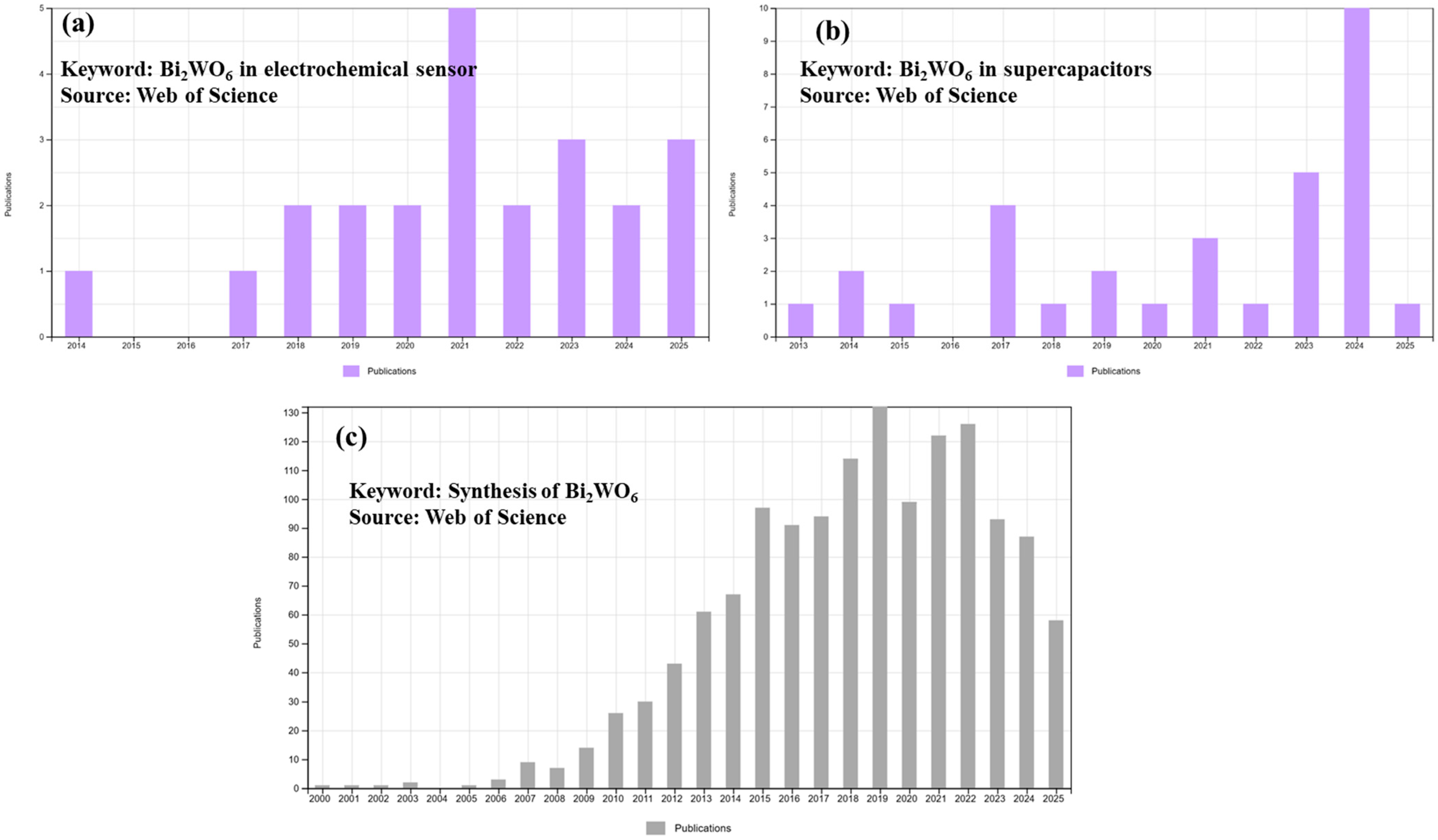
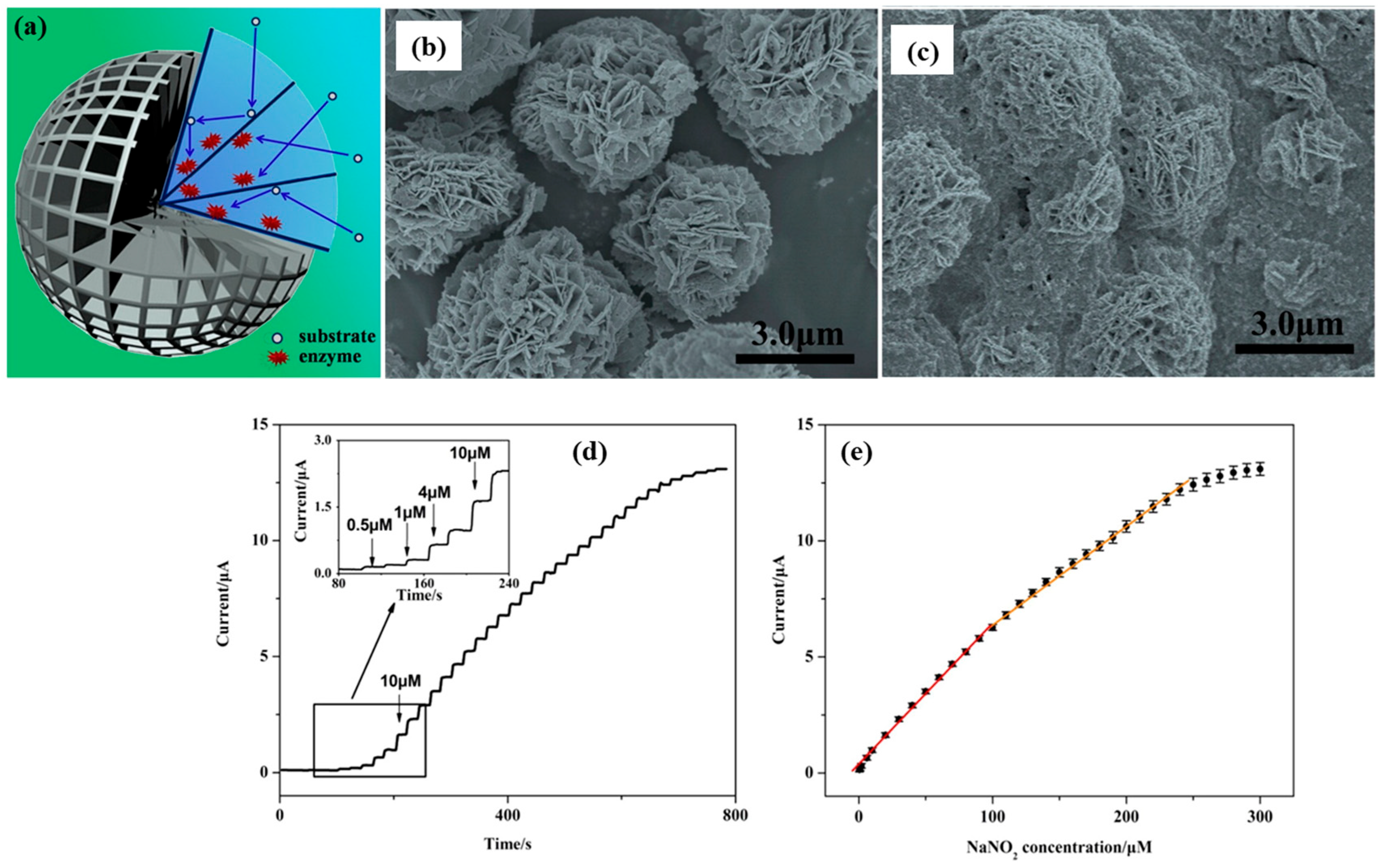
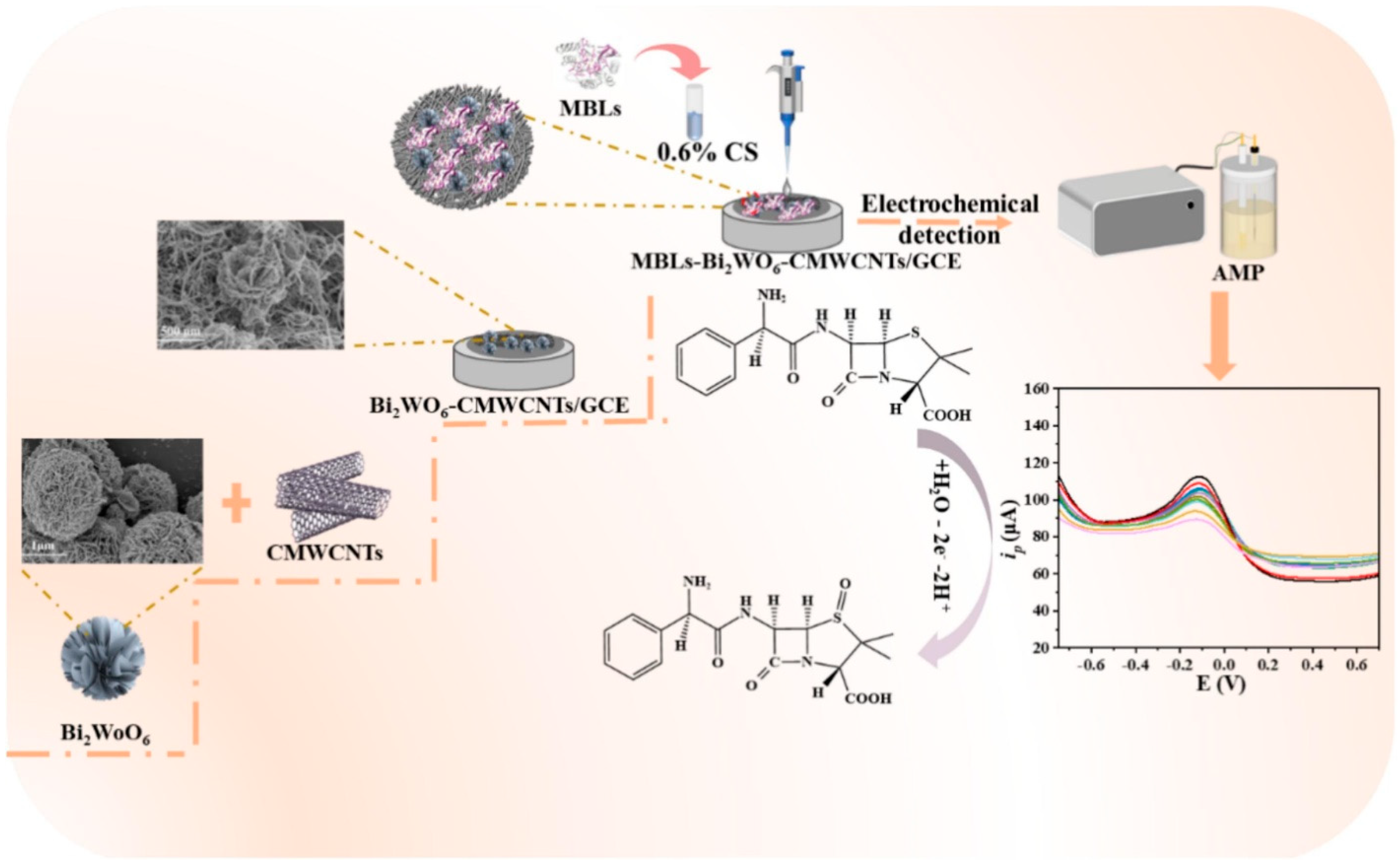

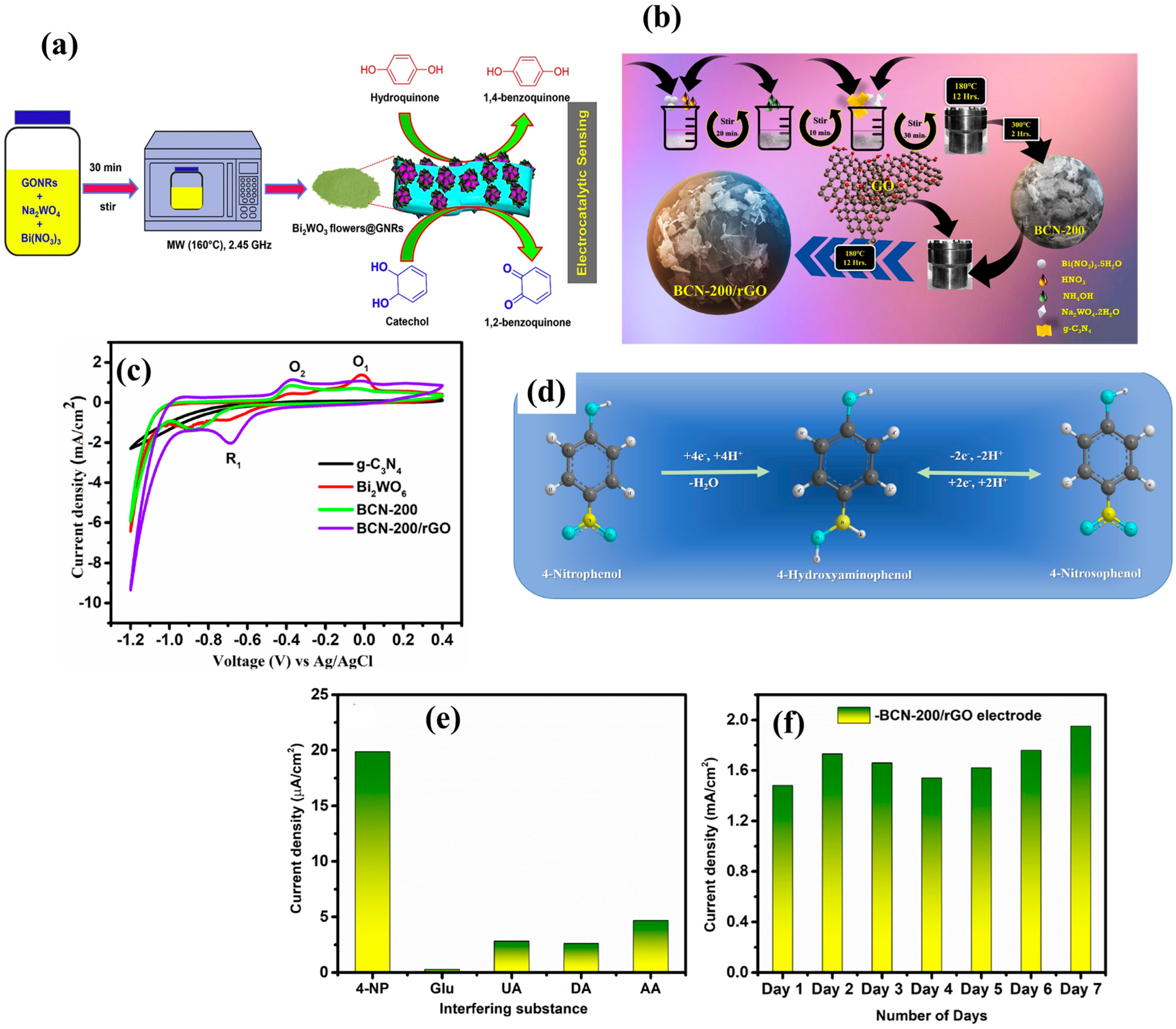

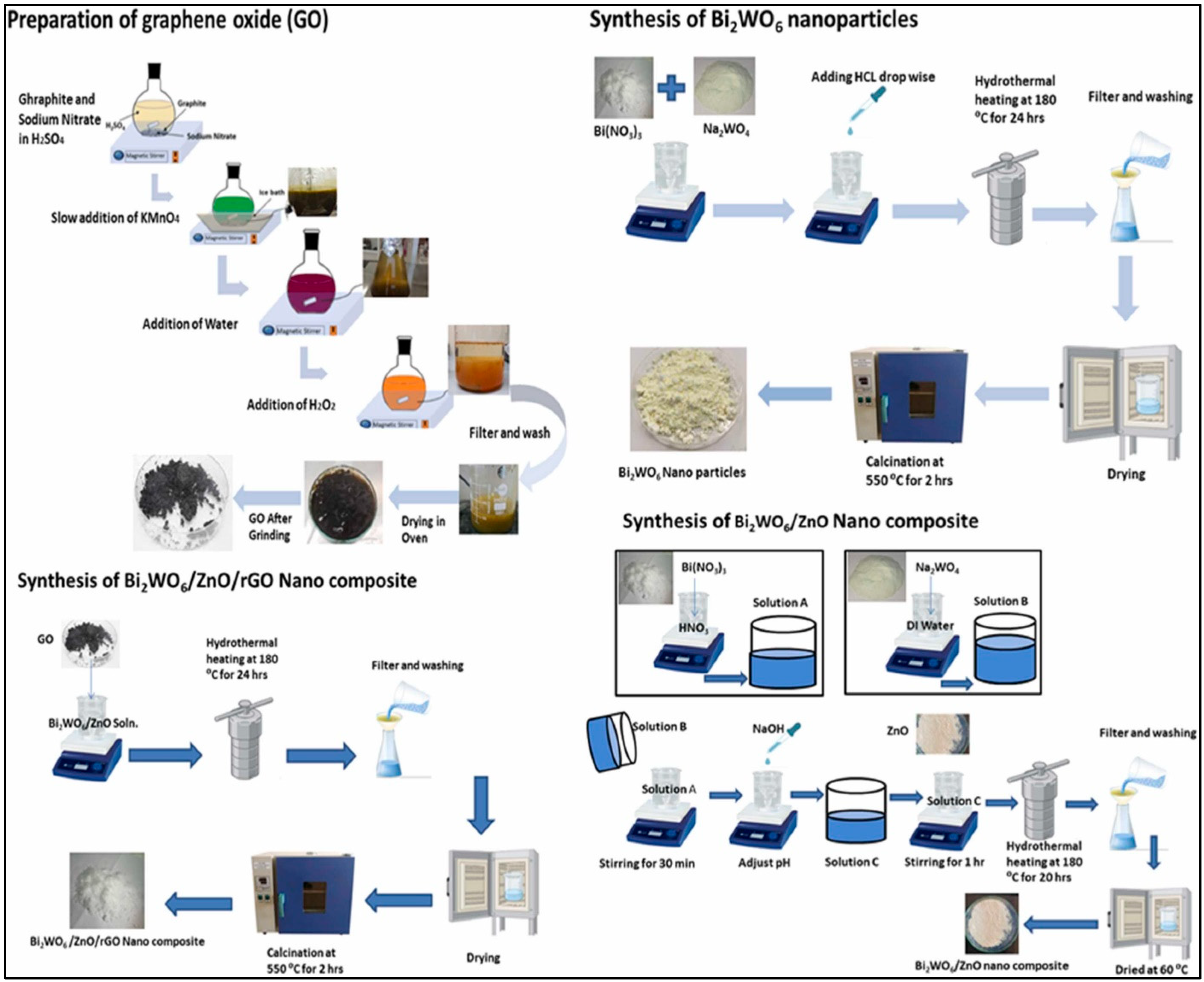
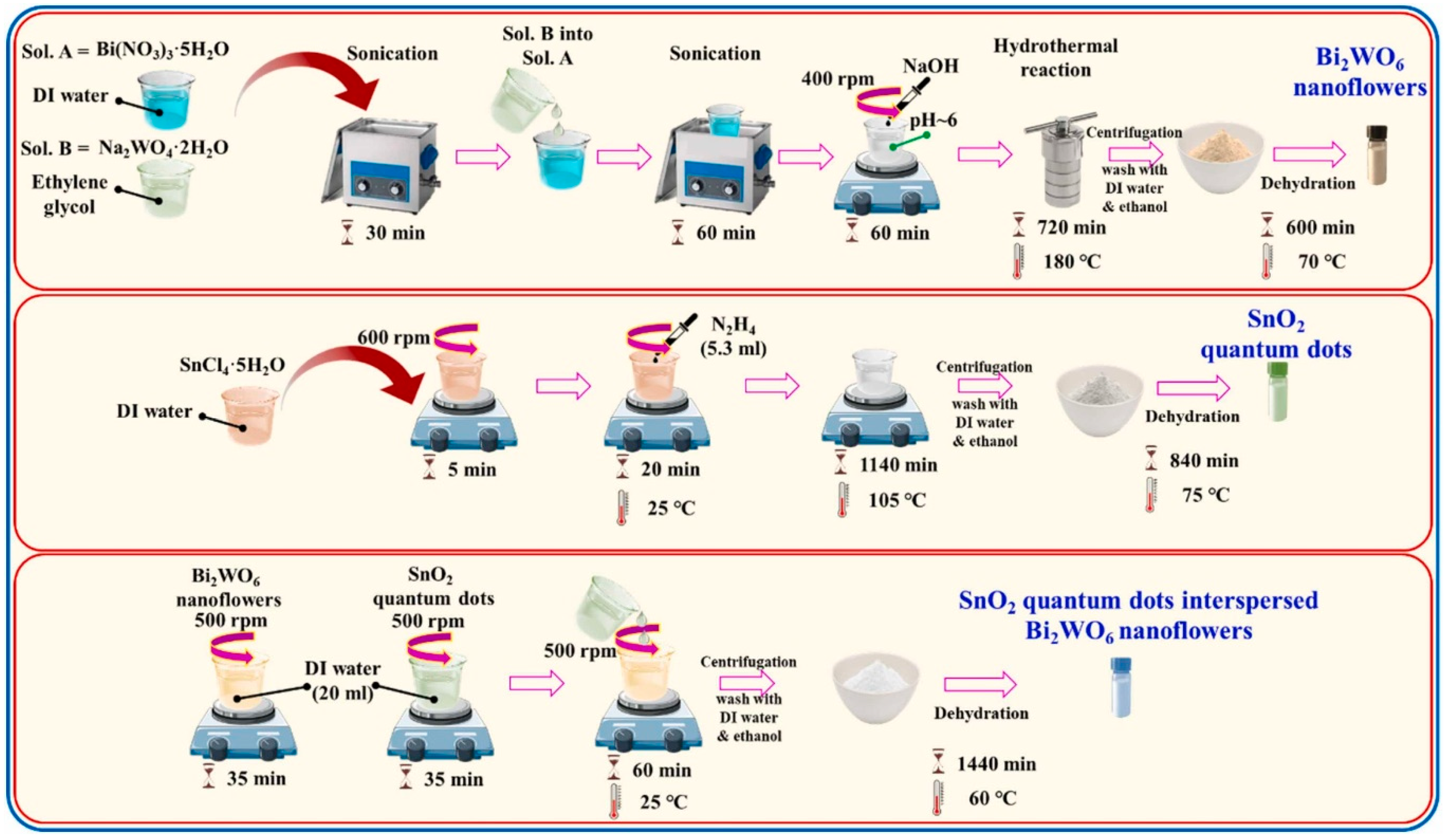
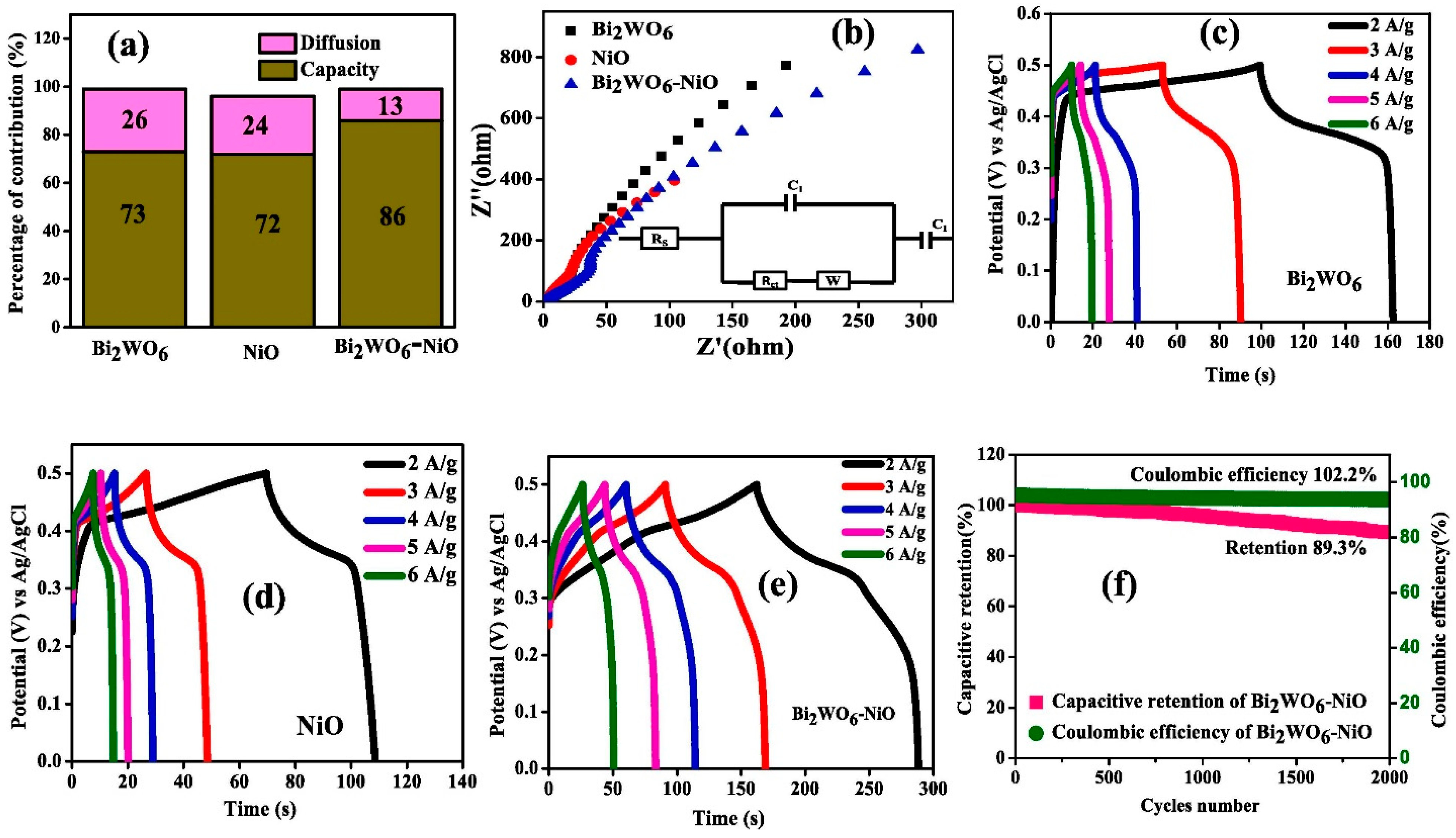
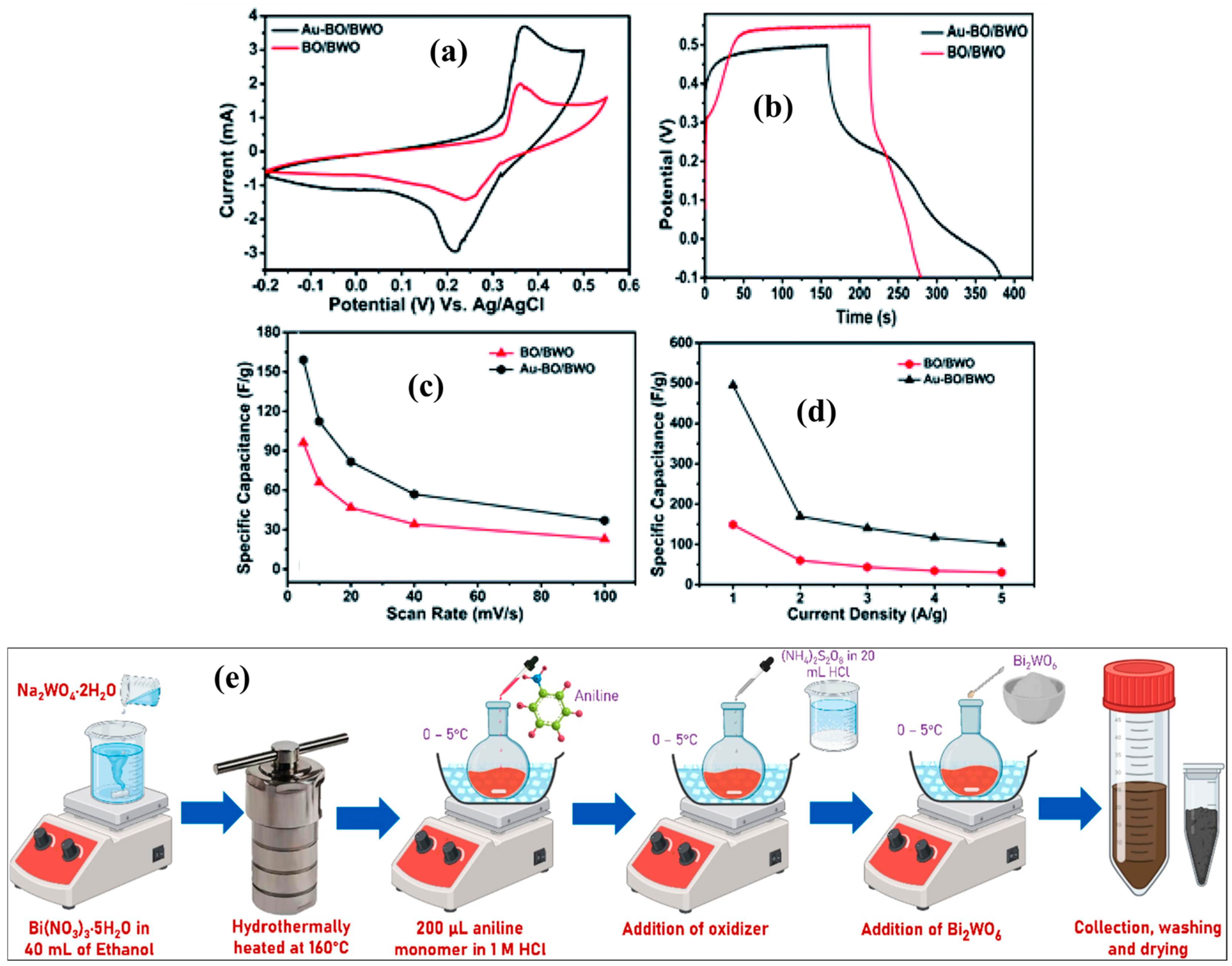
| Electrode Material | Analyte | LOD | Sensitivity | LR | Technique | References |
|---|---|---|---|---|---|---|
| Bi2WO6 nanoplates@SPE | BPA | 20 nM | - | 70 nM to 1300 nM | DPV | 63 |
| Bi2WO6 nanoplates@SPE | DES | 15 nM | - | 50 nM to 2100 nM | DPV | 63 |
| Nafion/HRP/3D-Bi2WO6/GCE | H2O2 | 180 nM | - | 0.5 µM to 100 µM and 100 µM to 250 µM | AMP | 64 |
| Bi2WO6 NSs/GCE | Sudan I | 5 nM | 3.0563 µA µM−1 | 0.02 µM to 114.6 µM | DPV | 65 |
| TiO2/Bi2WO6/Ag/GCE | H2S | 80 nM | - | 0.5 μM to 300 μM | AMP (i-t) | 66 |
| Br-terminated 2D Bi2WO6 NSs | SMX | 5.44 µM | - | - | DPV | 67 |
| Bi2WO6 (PVP + NaOH)/GCE | RF | 12.151 nM | 1.1415 µA µM−1 cm−2 | 0.03 µM to 457 µM | DPV | 68 |
| Bi2WO6 | AA | 77.85 mM | 0.26 mM/mA | - | CV | 69 |
| MBLs/CS/Bi2WO6/MWCNTs-COOH/GCE | Ampicillin | 0.17 nM | - | 0.0007 µM to 0.05 µM and 0.1 µM to 10 µM | DPV | 70 |
| Bi2WO6 | HQ | 57 µM | - | 200 µM to 5 mM | SWV | 71 |
| Bi2WO6 | RS | 4.3 µM | - | 20 µM to 5 mM | SWV | 71 |
| Zn3(VO4)2/Bi2WO6 | Cotinine | 1 pM | - | 1 nM to 5 µM | CV | 72 |
| Bi2WO6 | Nicotine | 13 nM | 56.97 ± 2 μM–1 | 50 nM to 100 μM | I-V/Amp | 61 |
| CoTAPc-GO/Cu-Bi2WO6 | DA | 7.2 nM | 0.05 µM to 5 µM and 5 µM to 250 | PEC | 74 | |
| ITO/Bi2WO6/CdS/Ab/BSA | Amyloid beta | 0.068 pg mL−1 | - | 0.2 pg mL−1 to 50 ng mL−1 | PEC | 75 |
| Bi2WO6@GNRs | HQ | 7.51 nM | 42.2 μA μM−1 cm−2 | 0.021 µM to 1550 µM | DPV | 76 |
| Bi2WO6@GNRs | CC | 5.31 nM | 54.14 μA μM−1 cm−2 | 0.021 µM to 1550 µM | DPV | 76 |
| BCN-200/rGO | 4-NP | 14 nM | 12.86 μA μM−1 cm−2 | 0.2 μM to 100 μM | DPV | 77 |
| Bi2WO6/rGOS | 4-NQO | 0.006 µM | - | 0.025 µM to 718 µM | Amp | 78 |
| Bi2WO6/Nb4C3Tx/ds-DNA/SPE | Pemetrexed | 2.8 nM | - | 0.01 µM to 100 µM | DPV | 80 |
| g-C3N4/Au/WO3 | SARS-CoV-2 NP | 3 fg mL−1 | - | - | DPV | 81 |
| CoPc/Bi2WO6 | Nitrite | 0.063 µM | - | - | DPV/Amp | 82 |
| CoPc@Bi2WO6 | Nitrite | 0.12 µM | - | - | DPV/Amp | 82 |
| MIPs/Bi2WO6@GH/ITO | 4-NP | 5.78 × 10−13 M | - | 5.0 × 10−12 M to 1.0 × 10−7 M | Amp | 84 |
| Electrode Material | Specific Capacitance | Electrolyte | Current Density | Cyclic Stability | References |
|---|---|---|---|---|---|
| 3D-Bi2WO6/NF | 1.12 F/cm2 | 2 M KOH | 1.5 mA/cm2 | 10,000 | 88 |
| BWS/RGO-12 | 1058 C/g | 6 M KOH | 3A/g | 10,000 | 95 |
| 3D BiVO4/Bi2WO6 | 616.8 F/g | 1 M KOH | 1 A/g | 4000 | 96 |
| Bi2WO6(BWO)/ZnO/rGO | 254.34 F/g | 2 M KOH | 2 A/g | - | 97 |
| BW/T@40 % | 1153.3 F/g | 2 M KOH | 1 A/g | - | 98 |
| Bi2WO6-SnO2 quantum dots | 812 F/g | 3 M KOH | 7 A/g | 3000 | 99 |
| Bi2WO6-NiO | 398.2 C/g | 3 M KOH | 10 mV/s | 2000 | 100 |
| Bi2WO6 (BWO-2) | 647 F/g | 1 M KOH | 5 mA/cm2 | 5000 | 89 |
| Flower-like hierarchical Bi2WO6 | 255 F/g | 1 M KOH | 0.5 mA/cm2 | 850 | 90 |
| Flake-like Bi2WO6 | 214 F/g | 1 M KOH | 0.5 mA/cm2 | 850 | 90 |
| Spherical structure Bi2WO6 | 412 F/g | 1 M KOH | 0.5 mA/cm2 | 850 | 90 |
| 3D Bi2WO6/rGO | 268.7 F/g | 6 M KOH | 0.75 A/g | 1000 | 101 |
| Bi2WO6/graphene | 922 F/g | 6 M KOH | 3 A/g | 2000 | 102 |
| MIL-53(Al)/Bi2WO6 | 220 F/g | 3 M KOH | 0.5 A/g | 5000 | 103 |
| Bi2(WO4)3/aniline/CB | 306 F/g | 1 M KOH | 1 A/g | - | 104 |
| Bi2WO6-g-C3N4 | 158 mF/g | 6 M KOH | 1 mA/cm2 | 1000 | 105 |
| Bi2WO6/graphene | 714 F/g | 6 M KOH | 4 A/g | - | 106 |
| MIL-53(Al)/Bi2WO6 | 554 F/g | 6 M KOH | 0.5 A/g | - | 107 |
| BWO-600 | 614 C/g | 6 M KOH | 2 A/g | 10,000 | 91 |
| CuBW80 | 1137 F/g | 3 M KOH | 0.5 A/g | 10,000 | 108 |
| Bi2O3/Bi2WO6 | 495.05 F/g | 1 M KOH | 1 A/g | 2000 | 109 |
| BW-BIC-PANI200 | 156 A/g | 3 M KOH | 1 A/g | 4000 | 110 |
| ABW@MXene | 1420 F/g | 1 M KOH | 1 A/g | - | 111 |
| PVP-assisted Bi2WO6 | 462 F/g | 1 M KOH | 3 mA/cm2 | 500 | 93 |
| HMT assisted Bi2WO6 NPs | 708 F/g | 1 M KOH | 3 mA/cm2 | 5000 | 94 |
Disclaimer/Publisher’s Note: The statements, opinions and data contained in all publications are solely those of the individual author(s) and contributor(s) and not of MDPI and/or the editor(s). MDPI and/or the editor(s) disclaim responsibility for any injury to people or property resulting from any ideas, methods, instructions or products referred to in the content. |
© 2025 by the authors. Licensee MDPI, Basel, Switzerland. This article is an open access article distributed under the terms and conditions of the Creative Commons Attribution (CC BY) license (https://creativecommons.org/licenses/by/4.0/).
Share and Cite
Ahmad, K.; Karmegam, D.; Oh, T.H. Progress in Bi2WO6-Based Materials for Electrochemical Sensing and Supercapacitor Applications. Molecules 2025, 30, 3149. https://doi.org/10.3390/molecules30153149
Ahmad K, Karmegam D, Oh TH. Progress in Bi2WO6-Based Materials for Electrochemical Sensing and Supercapacitor Applications. Molecules. 2025; 30(15):3149. https://doi.org/10.3390/molecules30153149
Chicago/Turabian StyleAhmad, Khursheed, Dhanabalan Karmegam, and Tae Hwan Oh. 2025. "Progress in Bi2WO6-Based Materials for Electrochemical Sensing and Supercapacitor Applications" Molecules 30, no. 15: 3149. https://doi.org/10.3390/molecules30153149
APA StyleAhmad, K., Karmegam, D., & Oh, T. H. (2025). Progress in Bi2WO6-Based Materials for Electrochemical Sensing and Supercapacitor Applications. Molecules, 30(15), 3149. https://doi.org/10.3390/molecules30153149






